| dc.contributor.author | Helleren, Stig | eng |
| dc.date.accessioned | 2006-06-21T12:24:52Z | |
| dc.date.accessioned | 2020-12-10T06:34:12Z | |
| dc.date.available | 2006-06-21T12:24:52Z | |
| dc.date.available | 2020-12-10T06:34:12Z | |
| dc.date.issued | 2004-12 | eng |
| dc.identifier.issn | 1503-0946 | |
| dc.identifier.uri | https://hdl.handle.net/1956/1348 | |
| dc.description.abstract | This paper is based on a qualitative case study of the Norwegian Labour Inspection Authority (LIA). It explores two recurring themes in public administration. One is the conflict that arises when contradictory tasks are placed within a single public body. The Working Environment Act establishes that the LIA are to exercise control over the their subjects in order to ascertain whether they are operating in accordance with the rules of the law, while at the same time providing guidance as how to improve working conditions. In an increasingly complex society, doubts have been raised as to whether such contradictory roles are feasible. The other theme explored in this paper concerns the challenge of balancing agency autonomy and political–administrative control. The LIA are formally subjected to political control, yet have a fair amount of autonomy within the framework set out by its political superiors. Recent political reforms have sought to clarify the relationship between autonomy and control, in order to make the agencies more accountable for the outcome of their activities. By combining various sources, such as interviews, documents and secondary literature, this paper traces the evolvement of LIA inspection policy in the time period from 1989 through 2004. Furthermore, it assesses whether policy changes made during this period can be attributed to autonomous deliberations, whether the changes were inspired by influential actors in the organizational environments, or whether political guidelines directly or indirectly forced the LIA to alter their inspection policy. The policy changes are explained by three different theoretical approaches: A perspective attributing change to hierarchic governance, a perspective attributing change to influence by the institutional environments, and a perspective attributing change to lesson-drawing. The paper notes that LIA inspection policy has been the subject of shifting preferences throughout the years. During the years from 1989 to 1994, the LIA considered their main task to be providing their subjects with guidance in order to improve working conditions, whereas in 1994–2002 the emphasis was placed firmly on a more controlling role. In 2002, it was again decided that providing guidance was preferable to exercising rigid control. Policy changes appear to have been a result of interplay between autonomous deliberations, influence by actors in the organizational environments, and political guidelines. | en_US |
| dc.description.abstract | Arbeidstilsynet er lovpålagt å opptre i to ulike roller som i utgangspunktet representerer en motsats til hverandre. Kontrollørrollen og veilederrollen hviler på ulike typer autoritet, krever ulike typer kompetanse, og uttrykker motstridende syn på hvorvidt tilsynsobjektene har vilje eller evne til å overholde lovbestemmelsene. I dette notatet blir det illustrert hvordan Arbeidstilsynet har håndtert denne rollekonflikten gjennom å beskrive etatens vekslende tilsynsstrategier i tidsrommet 1989–2004. Videre blir det gitt en vurdering av ulike faktorer som påvirker etatens beslutninger gjennom en vurdering av hvorvidt policyendringene i perioden hadde sine røtter i autonome avveininger, om autonomien ble avgrenset av påvirkning fra etatens omgivelser, eller om endringene kom som en konsekvens av politiske føringer. Policyendringene blir forklart ved hjelp av tre ulike teoretiske innfallsvinkler: Et perspektiv som antar at endring er resultat av hierarkisk instruks, et perspektiv som antar at endring er resultat av tilpasning til institusjonelle omgivelser, og et perspektiv som antar at endring er resultat av erfaringsbasert læring. Datagrunnlaget er et bredt tilfang av skriftlige kilder, samt intervjuer med en rekke sentralt plasserte personer i etaten. Notatet viser at det over tid har vært en labil balanse i forholdet mellom kontroll og veiledning i Arbeidstilsynets tenkning. Tre distinkte tilsynsfilosofiske paradigmer blir identifisert; i årene fra 1989 til 1994 ble veiledning ansett som det mest egnede virkemiddel, i årene fra 1994 til 2002 ble det lagt mer vekt på kontroll, mens pendelen svingte tilbake i retning av veiledning igjen i 2002. Policybeslutningene treffes i en vekselvirkning mellom autonome avveininger, påvirkning fra omgivelsene og politiske styringssignaler, der det varierer hvilken faktor som er utslagsgivende. | no |
| dc.format.extent | 457720 bytes | eng |
| dc.format.mimetype | application/pdf | eng |
| dc.language.iso | nob | eng |
| dc.publisher | Stein Rokkan Centre for Social Studies | eng |
| dc.relation.ispartofseries | 26-2004 | en |
| dc.relation.ispartofseries | Notat | no |
| dc.title | Arbeidstilsynets rollekonflikt: Vekslende tilsynsstrategier mellom kontroll og veiledning | nob |
| dc.type | Working paper | eng |
| dc.subject.nsi | VDP::Samfunnsvitenskap: 200 | nob |
